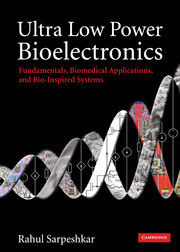Book contents
- Frontmatter
- Contents
- Acknowledgements
- Section I Foundations
- Section II Low-power analog and biomedical circuits
- Section III Low-power RF and energy-harvesting circuits for biomedical systems
- 16 Wireless inductive power links for medical implants
- 17 Energy-harvesting RF antenna power links
- 18 Low-power RF telemetry in biomedical implants
- Section IV Biomedical electronic systems
- Section V Principles for ultra-low-power analog and digital design
- Section VI Bio-inspired systems
- Section VII Energy sources
- Bibliography
- Index
- Epilogue
- References
16 - Wireless inductive power links for medical implants
from Section III - Low-power RF and energy-harvesting circuits for biomedical systems
Published online by Cambridge University Press: 02 December 2010
- Frontmatter
- Contents
- Acknowledgements
- Section I Foundations
- Section II Low-power analog and biomedical circuits
- Section III Low-power RF and energy-harvesting circuits for biomedical systems
- 16 Wireless inductive power links for medical implants
- 17 Energy-harvesting RF antenna power links
- 18 Low-power RF telemetry in biomedical implants
- Section IV Biomedical electronic systems
- Section V Principles for ultra-low-power analog and digital design
- Section VI Bio-inspired systems
- Section VII Energy sources
- Bibliography
- Index
- Epilogue
- References
Summary
I do not think there is any thrill that can go through the human heart like that felt by the inventor as he sees some creation of the brain unfolding to success … Such emotions make a man forget food, sleep, friends, love, everything.
Nikola TeslaImplanted medical devices are rapidly becoming ubiquitous. They are used in a wide variety of medical conditions such as pacemakers for cardiac arrhythmia, cochlear implants for deafness, deep-brain stimulators for Parkinson's disease, spinal-cord stimulators for the control of pain, and preliminary retinal implants for blindness. They are being actively researched in brain-machine interfaces for paralysis, epilepsy, stroke, and blindness. In the future, there will undoubtedly be electronically controlled drug-releasing implants for a wide variety of hormonal, autoimmune, and carcinogenic disorders. All such devices need to be small and operate with low power to make chronic and portable medical implants possible. They are most often powered by inductive radio-frequency (RF) links to avoid the need for implanted batteries, which can potentially lose all their charge or necessitate re-surgery if they need to be replaced. Even when such devices have implanted batteries or ultra-capacitors, an increasing trend in upcoming fully implanted systems, wireless recharging of the battery or ultra-capacitor through RF links is periodically necessary.
Figure 16.1 shows the basic structure of an inductive power link system for an example implant. An RF power amplifier drives a primary RF coil which sends power inductively across the skin of the patient to a secondary RF coil.
- Type
- Chapter
- Information
- Ultra Low Power BioelectronicsFundamentals, Biomedical Applications, and Bio-Inspired Systems, pp. 421 - 453Publisher: Cambridge University PressPrint publication year: 2010



